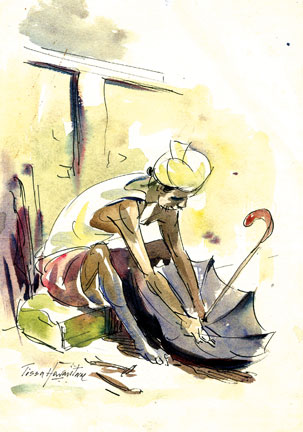The impact of water on line and wash paintings
by Tissa Hewavitarane
The first technique a beginner needs to know to get started in
watercolour is the wash technique. So, when doing a drawing with pen and
ink learn to observe, feel free to experiment different techniques in
drawing and painting human figure or a landscape.
The principle of watercolour painting is simple. All one needs to do
is wet the brush with colour and water and spread it over the paper. A
small amount of paint is placed on the pallette.
 Watercolour paint from the tube is denser and more concentrated than
solid colours, which are wetted and softened by running the brush back
and forth across the paper. Once the colour is on the palette, water is
added with the brush. The more water you add, the more transparent the
tone appears. Watercolour paint from the tube is denser and more concentrated than
solid colours, which are wetted and softened by running the brush back
and forth across the paper. Once the colour is on the palette, water is
added with the brush. The more water you add, the more transparent the
tone appears.
Water
While you have mixed the colour on the palette a little water is
added with the brush to lighten the colour. First apply the colour with
a moist brush. Next wash the brush in water, rinse and spread the colour
on the paper. By then a tone is made more transparent by adding more
water each time. As a result you can obtain a gradation of tone.
Moistening the paper before you apply colour is the best way to
execute gradation. Paint is applied when the gradation begins. Since the
paper is wet, the colour will spread much ore easily. The more you
extend the gradation, in this way, the colour seeps into wet area, and
the wet paper allows the paint to spread on its own.
Background
The wash technique is apparently simple. It mainly consist of leading
some paint on wet brush and applying it to the paper stretching it out
by adding large amounts of water to obtain gradation of the tone from
dark to light.
As the gradation becomes lighter, the tones become so light that it
can barely be distinguished from the white paper.
Line drawing with wash paint has always been a favourite of mine
using pen. This time proven art form allows the artist to create bold
eye-catching compositions with rich textures and striking values
contrasts. The bold lines produced by a fine pen nib can produce
detailed work on wash.
Observe the line and wash drawing reproduced here the umbrella
mender. Notice the figure drawn with line capturing the characteristic
mood of the mender. A light wash of burnt sienna is applied to create
tonal variety.
The emotional impact of the lines and strokes on the painting which
are compatible with mood you want to capture is expressed clearly.
Pigments
The colours achieved in this painting are the result of not just the
pigments used, but also when and how they're applied, with dark shades.
The quality and depth of colour gained is delivered in this way.
Despite the fact that wash is excuted with watercolour, it is really a
drawing technique. No matter. Whether you are experienced in drawing or
not, you will see how closely the wash is linked to drawing.
The brush is used to apply shading progressing from dark to light
where the artist can achieve a greater number of tones. A wash allows
the artist to paint different tones of various colour, according to the
amount of water that is added to the paint on the palette.
A figure sketch is more dramatic than a still life or a landscape. A
human figure brings into play a higher number of more complicated
recourses both for shading and colour. The mender is sketched with rapid
strokes. Observe the proportions between the elements of the body and
how the principle lines relate to each other.
I have completed the painting using very little colours. A pale
yellowish colour applied for the back ground and purplish blue to the
vendor and the umbrella with a dark shade of burnt sienna mixed with
purple applied to the back of the umbrella.
Painting on wet paper
Perhaps the flashest technique in painting is that of flowing
richcolours on to a wet surface and watching the resulting mixtures,
flows and blending. The control of wet technique takes much practice,
but the rewards are often quite exhilarating. The paper can be prepared
in several ways. Heavy papers must be soaked for 10 minutes or more in a
tub or large basin until limp, really wet all the way through.
Lighter paper can be sponged with clear water or a coloured wash on
both sides. Papers can be kept workably wet during the painting process
by laying them on a glass sheet, formica table or other non absorbent
surface. As the water evaporates and the sheet becomes drier, the edges
of the freshly applied colour will grow harder and more crisp.
If it is desirable to have the paper dry faster, lay it on a wooden
drawing board, or a sheet of blotting paper while working. Each artist
has a pet way of speeding up or slowing down the drying time, and each
is developed after years of experimenting. |

